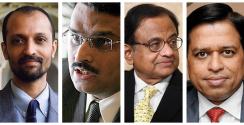When the Indian parliament passed the Electricity Act of 2003, lawmakers hoped to transform the country’s backward power sector and provide a jolt to the economy. The measure sought to break up the effective monopoly that state electricity boards had over power transmission and introduce a free-market approach under which multiple generating companies would compete to sell electricity to a variety of distributors. Advocates asserted that the new arrangements would spur an increase in private investment in the sector and spread the power grid to India’s most impoverished districts.
A decade later the results have been anything but electrifying. Private companies have invested more than $100 billion in new power plants, but transmission and distribution remain almost entirely in public hands, with no hint of privatization on the horizon. Fully 97 percent of the country’s power is controlled by state electricity boards; the prices they can charge consumers are tightly regulated and typically often set below the actual cost of generation by politicians determined to provide cheap power to their constituents. As a result, the state-owned utilities have fallen deeply into the red, owing some $35 billion to generating companies and banks.
“Most of the state electricity boards are unable to pay their dues to private generators, primarily because power tariffs are state-regulated, hence strongly influenced by politics rather than market forces,” says Nomi Ahmad, chief operating officer of Lanco International, a Singapore-based arm of India’s Lanco Infratech. Over the past decade Lanco has invested more than $2 billion in 14 power projects with a total capacity of 9,300 megawatts. The company often waits up to 60 days for payment from state electricity boards and is seeking arbitration over $300 million it claims it is owed for power delivered to the southwestern state of Karnataka.
The result of the flawed reform effort manifested itself dramatically last July in a sweeping blackout that cut power to an estimated 620 million people across northern and eastern India for as long as two days. The country remains woefully underpowered. Installed generating capacity for India’s 1.2 billion people currently stands at 145 gigawatts. By contrast, China has nearly ten times the power capacity — 1,140 gigawatts — for a population of 1.3 billion.
India isn’t just underpowered. It’s falling behind its big Asian neighbor in virtually every other aspect of infrastructure. In the past five years, China has built or is in the process of completing more than 5,800 miles of rail lines for high-speed trains, 50,000 miles of expressways and 82 new commercial airports. India, meanwhile, doesn’t even have a bullet train on the drawing board; its 71,000 miles of railroad were mostly built in decades past. In five years the country has constructed just 942 miles of new expressways and 17 new airports.
“India’s market has potential, and investors are interested, but there are structural issues,” says Lanco’s Ahmad, citing a lack of political consensus on economic reform, poor governance and inconsistency in policy administration.
Ahmad is far from alone in his complaints. At the Owners Forum, a gathering of family-owned-business leaders from Germany, India and the Middle East held in New Delhi last month, Kumar Mangalam Birla, chairman of Aditya Birla Group, bemoaned excessive red tape that he contended made India less attractive than other emerging markets, such as Brazil, where his company could invest with more certainty. Aditya Birla, the country’s third-largest conglomerate, with more than $40 billion in annual revenue from interests including cement, fertilizer, aluminum and textiles, was facing bureaucratic delays on one investment project, which the chairman declined to specify. “Getting delayed by a few months, two months, seems to be the most normal thing in India at the moment,” Birla told the audience. “So I think the country risk for India is pretty elevated, and chances are if you have a pool of capital, you would look to see if there is an asset overseas rather than in India.”
The pessimism among investors is reflected in India’s recent subpar economic performance. The country enjoyed a tremendous growth spurt during the past decade, with output expanding at an average annual rate of 8.6 percent between 2004 and 2008. Many analysts proclaimed that India had finally broken into the same supercharged-growth league as China. But the global financial crisis combined with a stalling of economic reform efforts at home to produce a dramatic cooling. The economy grew by just 4.9 percent last year, the slowest rate in a decade. In its latest report on India, the International Monetary Fund attributed the slowdown to “supply constraints and an unsupportive policy environment,” including an inflation rate that’s currently running at nearly 7 percent and twin budget and current-account deficits. The economic woes, in turn, have caused the rupee to fall by nearly 18 percent over the past 20 months, to 54.20 to the dollar in late March.
Although the IMF forecasts that growth will pick up to 5.9 percent this year and 6.4 percent in 2014, that will still lag China’s 8 percent-plus pace. The Reserve Bank of India recently lowered its estimate of the country’s potential growth rate by 1 point, to 7 percent, citing structural factors like infrastructure bottlenecks.
Ajit Ranade, chief economist at Aditya Birla, notes that overall investment has fallen to 30 percent of gross domestic product from a high of 33 percent in 2008. The global financial crisis is partly to blame for the decline, he says, but “there also has been a slowdown in decision making. There is some policy gridlock.”
For a country with stark inequality and ex-tensive poverty, the slackening in the economy is troubling. India is home to 61 U.S.-dollar billionaires, and the 100 wealthiest families collectively control some $240 billion in assets, but 32 percent of the population lives on $1.25 a day or less, more than twice as high as in neighboring China, where the comparable poverty rate is 13 percent. A failure to restore growth to the rates enjoyed in the mid-2000s will mean an extra 35 million people living in poverty, the IMF estimates.
Such poverty in itself can act as a barrier to development. In the power sector, for example, the nation needs to add more than 75,000 megawatts of generating capacity over the next five years to support New Delhi’s growth target, according to a recent government report. That will cost roughly 11 trillion rupees ($203 billion), with half of that sum expected to come from private investment. But most private investors, especially those from abroad, are shying away from the sector because of poor economics. “Many state electricity boards are essentially bankrupt,” says David Appleyard, chief editor of online newsletter Renewable Energy World. “People can’t afford to pay the market rates for power.”

In an effort to revive growth and address investor concerns about the government’s commitment to reform, Prime Minister Manmohan Singh called Palaniappan Chidambaram back to the Finance Ministry last July. Chidambaram, a former lawyer who holds an MBA from Harvard Business School, had held that post from 2004 to 2008, and his disciplined management of India’s finances helped foster the economy’s growth spurt during those years. Singh appointed him Home Affairs minister in November 2008 following the terrorist attacks that killed more than 160 people in Mumbai that month.
Shortly after last July’s cabinet shake-up, the government announced the creation of the Cabinet Committee on Investment, headed by the prime minister, to accelerate the approval process for all investment projects worth Rs10 billion or more. In the fourth quarter of 2012, there were 98 projects worth Rs710 billion stalled for a variety of reasons, including environmental and procedural grounds as well as local opposition, according to the Center for Monitoring Indian Economy, a Mumbai-based research firm. The new committee, formally established in December, was intended to cut through the red tape that had stymied many of those projects. “We know the problem of investment backlogs is severe enough, because the minister of Finance recognizes it,” says Rana Hasan, a Mumbai-based economist for the Asian Development Bank.
In September the government sent another strong liberalization signal when the cabinet announced that foreign investors would be allowed to hold stakes of as much as 51 percent in supermarket ventures set up with local partners and take stakes as high as 49 percent in Indian airlines. Those moves followed on the government’s announcement earlier in the year that foreign single-brand retailers such as Ikea could set up wholly owned operations. The change was an important symbolic step for the government, which had abandoned previous efforts to open the market to big-box retailers like Wal-Mart Stores in the face of heated opposition from populists who contended it would threaten the livelihoods of small shopkeepers.
In February the government announced a plan to restructure the massive debts of state electric utilities by 2015. It requires local authorities to raise tariffs to keep up with the costs of production. “We are hopeful things will improve by 2015,” says K. Raja Gopal, CEO of Lanco Infratech’s power-generating subsidiary.
Investors welcome the government’s recent moves. “Yes, we see main headwinds to India’s growth story emanating from a combination of high current-account deficit, high and sticky consumer inflation, high fiscal deficit and limited headroom for monetary policy loosening,” says Manoj Thakur, chief executive of Avendus PE Investment Advisors, a Mumbai private equity firm. “However, we see several signs for optimism in the recent spate of government policy announcements.”
Chidambaram went on the road to persuade foreign investors that the government was committed to its new reform agenda. At a January meeting with more than 200 global equity and bond investors hosted by Citigroup in Hong Kong, the Finance minister provided assurances that the new cabinet committee would begin clearing up the investment backlog and said the government was determined to get growth back to the 8 percent level by 2015, according to Aditya Narain, a Citi equity analyst in Mumbai. “The Finance minister was both clear and confident — of what needs to be done, how and when it will be done, and time lines,” he notes.
Others say that although they welcome the government’s recent initiatives, officials still have work to do to allay concerns about India’s attractiveness as an investment destination. “These must be addressed before India takes off again,” says Roopa Kudva, chief executive officer of Crisil, a Mumbai-based rating agency that is controlled by Standard & Poor’s.
In the near term, however, electoral concerns may dim the prospects of further liberalization.
At the end of February, Chidambaram unveiled a budget for the fiscal year beginning April 1 that contained a sharp 17 percent jump in spending, to Rs16.7 trillion, financed by new taxes on large companies and the rich. The increased spending focuses on education and training to help get youths into the job market, as well as fuel subsidies and investment-linked tax rebates for growth industries.
The budget package was regarded as a clear attempt to boost growth ahead of elections that are due to be called by the middle of 2014. It disappointed many analysts, who had been hoping the government would take steps to reduce a deficit that the IMF projects at about 5.8 percent of GDP for the central government — 8.7 percent of GDP when state and local governments are included. Those figures represent by far the largest deficit among a group of ten leading emerging-markets economies: the so-called BRICS nations — Brazil, Russia, India, China and South Africa — as well as Indonesia, Mexico, South Korea, Thailand and Turkey. Under Chidambaram’s budget the central government deficit will dip to 5.2 percent of GDP in the new fiscal year.
“Policy paralysis is a continuing risk,” says Takahira Ogawa, director of sovereign ratings at S&P in Singapore, whose team published a critical report last June titled “Will India Be the First BRIC Fallen Angel?” He adds, “With the general election in sight, it may be difficult for the government to implement structural reforms, which are often unpopular with the general public.”
Indian politicians and policymakers face a conundrum, analysts say. Their investment-driven growth model has brought huge wealth to a group of business families and elites, but it has not yet succeeded in reducing poverty as fast as their aspirational citizenry desires. Infrastructure holds the key to maintaining strong growth, but social activists wary of foreign investment, and a lack of consensus on policy among the country’s many political parties, are impeding efforts to boost spending in this area. Singh’s Indian National Congress party heads the United Progressive Alliance government, which includes a coalition of leftist parties led by the Communist Party of India, a group that openly questions the need for market reforms. The UPA will be running against the conservative Hindu nationalist Bharatiya Janata Party, which ruled the country from 1998 to 2004 and enjoys a strong lead over the UPA in opinion polls.
“In China there is a lot of alignment on economic growth and value creation, from the politburo down to village party chiefs,” says Aditya Birla’s Ranade. India, by contrast, is a democracy that lacks that degree of political consensus, he notes.
Notwithstanding its problems, the Indian economy retains some undeniable strengths. Growth in rural areas, driven by agriculture and fueling the rise of small and medium-size enterprises there, is providing fertile grounds for expansion at Bank of Baroda, the country’s largest state-owned lender. The bank, which has more than 4,200 branches, has been opening as many as 500 new branches a year recently and plans to continue at that pace, says chairman S.S. Mundra.
“The rural areas are better off than in the past,” he says. “There will be demand for mortgages, for SME loans. This will continue for the next decade or two. This will not slow down.” But even Baroda is beginning to feel the pain of a slowing economy. The bank reported a 21.6 percent decline in net profits in the quarter ended December 31, 2012, to Rs10 billion, breaking a string of 30 consecutive quarters of rising earnings. Lower treasury profits, higher provisions for bad loans and a rise in interest costs contributed to the decline. Mundra says the theory that a stall in reform momentum has sapped the Indian economy is overdone. “There have been some concerns about delays, especially in areas of mining and environmental clearances,” he acknowledges. But, he adds, “India is largely becoming better regulated. I am optimistic that most of these issues would be addressed over time.”
The country’s young population and growing consumer class also provide a boost to the economy. India has an emerging middle class of close to 400 million people, with annual incomes in the range of $4,000 to $10,000, says Crisil’s Kudva. “We have a population dividend in that half of the population is below the age of 25. That has very strong implications for demand for services, health care, auto, furniture and agricultural products. The demographic profile will be a big driver of growth.”
To tap that growth potential, however, the country needs to generate a substantial increase in investment.
India does start from a solid base. Foreign direct investment never exceeded $10 billion a year before 2005, but it has averaged $40 billion a year since 2007, notes the ADB’s Hasan. “It really has been the past five years that money has been flowing in so rapidly,” he says. The delays in approving new projects reflect an overburdened bureaucracy, not a backlash against foreign investment, Hasan contends: “It is because so much investment came in the past five years that they have overwhelmed the system with needing clearance.”
Yet red tape frustrates even those who are bullish on the India story. Mark Mobius, executive chairman of Templeton Emerging Markets Group, says he is looking to double his funds’ exposure to India but can’t get the necessary approvals because officials are scouring fund inflows for signs of tax evasion by Indian entrepreneurs who make capital gains abroad.
“There is somewhat of a confused philosophy of what they want to do,” Mobius says. “They want to tax the rich to help the poor, but at the same time they want to encourage the rich to invest. Part of the nature of the problem is bureaucratic. One hand isn’t cooperating with the other.” If not for bureaucratic delays, Mobius says, his $55 billion-in-assets group could easily have $10 billion invested in India instead of its current $5 billion.
Singh and Chidambaram will need to expedite procedures quickly because as much as foreign investment has increased in recent years, it has to accelerate further to meet India’s development needs. Hasan says India needs to ramp up its investment in infrastructure dramatically to narrow the gap with China.
Infrastructure spending has been a key driver of China’s economic ascent; the country has been spending an average of 11 percent of GDP a year on such projects, according to Hasan. Those investments have enabled China’s economy to grow by more than 9 percent a year for the past 30 years, reaching $8.25 trillion in 2012, second only to the U.S., according to IMF figures. By contrast, India spends about 6 percent of GDP a year on infrastructure. At $1.95 trillion, the country’s GDP was less than one quarter of China’s last year. In 1990, when both nations were starting to embark on economic reforms, India’s economy was 80 percent as large as China’s, at $327 billion.
India hasn’t been standing still. Investment in highways, ports, power plants and other infrastructure has totaled $425 billion in the past five years. The government wants to see that spending more than double, to $1 trillion, in the coming five years, in an effort to accelerate growth, says Pradeep Singh, vice chairman of IDFC Projects, a subsidiary of Infrastructure Development Finance Co., a joint public-private financing consortium.
Fully half of that investment is expected to come from the private sector. “Based on domestic resources, this means we will be short of the funds needed,” says the IDFC official. As a result, much of the financing — some $350 billion over the five-year period — will need to be borrowed, he adds.
Such large needs will require a major expansion of India’s bond market, says Crisil’s Kudva. According to the Reserve Bank of India, the total amount of corporate bonds outstanding equals 11.8 percent of GDP, compared with an average of 17.2 percent for emerging East Asian economies.
To meet India’s infrastructure goals, the country needs to court foreign investors. Notwithstanding their recent liberalization moves, Prime Minister Singh and Finance Minister Chidambaram have much work to do to counter the negative impact of some recent high-profile incidents.
Consider the case of Vodafone Group. The British mobile telephone giant paid $11.1 billion in 2007 to acquire control of Hutchison Essar, India’s second-largest mobile operator, from Hutchison Telecommunications International, a Hong Kong concern controlled by tycoon Li Ka-shing. Shortly after the deal closed, Indian tax authorities slapped Vodafone with a bill for $2.5 billion, contending that it represented capital gains taxes, penalties and interest.
Vodafone has refused to pay, arguing that a 1962 law stipulated that offshore transactions were not taxable (the deal was done through Cayman Islands subsidiaries). Even if the tax is owed, the company says, Hutchison should bear the liability. That argument proved persuasive to the Supreme Court of India, which in January 2012 ruled on behalf of Vodafone. Nevertheless, the Finance Ministry, with the backing of Parliament, changed the 1962 law last May and continues to demand payment from Vodafone.
Neither Vodafone nor the ministry would comment on the dispute, which sources say will be difficult to resolve, as the government seems intent on collecting the tax. “Vodafone didn’t earn a capital gain, and it seems unfair to go after them for taxes,” says Templeton’s Mobius. “Also, it is unfortunate that the tax authorities are unwilling to accept the court’s decision. This indicates to some foreign investors a lack of respect for the law.”
An executive at one foreign company operating in India, speaking on condition of anonymity, says global infrastructure companies will think twice before committing to any long-term projects. “India is in desperate need of infrastructure,” he says. “Vodafone has spent billions of dollars helping India build telecom networks. Their reward is a $2.5 billion slap in the face. Why would any major infrastructure builder come in now? There is no certainty in India.”
Jignesh Shah, chairman and chief executive of Financial Technologies (India), operator of the nation’s largest commodities and futures exchange, Multi-Commodity Exchange of India, echoes the calls for a more predictable stance by the authorities. “If there is no consistency in policy measures and taxation rules, it will jeopardize India’s growth prospects, far exceeding the huge opportunities that exist in the country,” he says.
South Korea’s Posco has been struggling with investment hurdles in India for longer than Vodafone. In 2005 the giant steelmaker signed an agreement with the state of Odisha, in northeastern India, to invest $12 billion in a massive plant capable of building 12 million tons of steel a year. Posco’s facility would include four blast furnaces, its own electricity plant and housing for many of its planned 13,000 workers. The authorities project that it would generate Rs8 billion a year in tax revenue.
Opposition from environmental groups and activists representing local villagers has stymied the project for years, though. Critics assert that the federal and state governments are violating India’s Forest Rights Act in trying to appropriate farmland and forests for the project, which will cover some 1,620 hectares (4,000 acres). Opposition politicians allege that the project would benefit only the company while displacing more people than it employed, damaging the environment and taking India’s mineral resources for a low price.
Posco hasn’t given up on the project and began clearing the land in early February, only to be stopped by local authorities after protesters arrived at the site. Company executives say they remain optimistic that they will get the project built and ready for production by 2018 — 13 years after signing the initial agreement.
The Posco saga underscores a broader issue regarding the difficulty of obtaining sufficient property for major projects, some of which require moving thousands of people out of slums. “India has fragmented land rights,” says Aditya Birla’s Ranade. “Land is mostly privately held in very small parcels. This is the big factor and obstacle toward industrialization and infrastructure development. You can’t just take it coercively from the people.”
The contrast with China is stark. In the People’s Republic land is collectively owned and the government can acquire or appropriate land-use rights by edict. In India private property rights are protected by the constitution. “We keep looking at China, and we look at the successes,” says Ranade, who sits on the Confederation of Indian Industry’s national economic policy council and is a member of the executive committee of the Federation of Indian Chambers of Commerce and Industry, two of the country’s most powerful industry groups. India’s attempts to address the land issue have yet to succeed in streamlining the process for major investments. “We try to go at it in various ways, perhaps piecemeal,” Ranade says.
Political and business leaders and civil society will need to work together much more effectively if they hope to unlock India’s vast potential and get the economy growing strongly again, says Financial Technologies’ Shah.
“We are not the only country where there are opportunities,” he says. “We will have to compete hard to attract the interest of the global investor community. The future for our youth, employment opportunities and wealth creation will all depend on this. Our journey from third world to first world is completely in our hands.” • •






